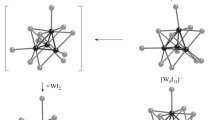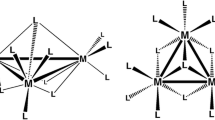Abstract
Four new compounds having nine cluster electrons and cores of the types Mo3OCl3, Mo3OBr3, and W3OCl3 are reported. Compound (1) prepared by reduction of [Bu4N][Mo3OCl6(OAc)3] in THF with metallic zinc, was shown by X-ray crystallography to be Mo3OCl4(OAc)3 (THF)2 (1). It forms crystals in space groupP21 with unit cell dimensionsa=9.472(2) Å,b=13.546(4) Å,c=9.652(2) Å, β=101.70(2)°,V=1201(1) Å3,Z=2. The [Mo3(μ3-O)(μ-Cl)3]4+ core is surrounded by three μ-O2CCH3 anions, one Cl−, and two THF and has Mo-Mo distances of 2.620(1) Å, 2.613(1) Å, and 2.530(1) Å, with the shortest bond between the two Mo atoms to which the THF molecules are coordinated. Compounds [Bu4N]2 [Mo3OBr6(O2CCH3)3] · Me2CO, (2) and [Mo3OBr3(O2CCH3)3(PMe3)3]3 · BF4, (3) are the first two nine-electron Mo3 species with a [Mo3(μ3-O) Br3]4+ core. Both were obtained by zinc reduction of [Mo3OBr6(O2CCH3)3]− in the presence of (NBu4) Br (2) or PMe3 and NaBF4 (3), and each was characterized crystallographically. Compound (2) crystallized in space group Cc with unit cell dimensionsa=25.037(5) Å,b=12.827(2) Å,c=21.484(4) Å, β=122.96(1)0,V=5790(3) Å3,Z=4. While the anion has no crystallographically required symmetry, its virtual symmetry is C3v . The Mo-Mo distances are 2.619(2) Å, 2.610(3) Å, 2.644(2) Å, with a mean value of 2.624[14] Å. Compound (3) crystallized in space groupP21/c with unit cell dimensionsa=10.846(2) Å,b=25.033(5) Å,c=12.641(5) Å, β=94.74(2)0,V=3420(2) Å3,Z=4. The cation occupies a general position but has virtual C3v symmetry, with Mo-Mo distances of 2.601(2) Å, 2.610(2) Å, 2.627(2) Å, with a mean value of 2.613[14] Å. Thus the anionic and cationic Mo3 clusters in (2) and (3), respectively, have average Mo-Mo distances that are equal within experimental error. Compound (4), [NEt4]2 [W3OCl6(O2CCH3)3] is the first 9-electron compound of this type containing tungsten. It was prepared by reduction of [Et4N][W3OCl6(OAc)3] in benzene with Na/Hg. It crystallized in space groupP212121 with unit cell dimensionsa=11.076(2) Å,b=14.345(2) Å,c=21.026(3) Å,V=3574(1) Å3,Z=4. The anion resides on a general position but has virtual C3v symmetry, with W-W distances of 2.577(1) Å, 2.612(1) Å, 2.584(1) Å and a mean value of 2.591[15] Å.
Similar content being viewed by others
References
F. A. Cotton, M. Shang, and Z. S. Sun (1991).J. Am. Chem. Soc. 113, 6917.
F. A. Cotton and X. Feng (1991).Inorg. Chem. 30, 3666.
F. A. Cotton, M. Shang, and Z. S. Sun.J. Cluster Sci. Submitted.
F. A. Cotton, M. Shang, and Z. S. Sun (1991).J. Am. Chem. Soc. 113, 3007.
A. Bino, F. A. Cotton, and P. E. Fanwick (1979).Inorg. Chem. 18, 3558;
F. A. Cotton, B. A. Frenz, G. Deganello, and A. Shaver (1973).J. Organomet. Chem. 50, 227.
A. Bino, F. A. Cotton, and Z. Dori (1979).J. Am. Chem. Soc. 101, 3842.
Author information
Authors and Affiliations
Rights and permissions
About this article
Cite this article
Cotton, F.A., Shang, M. & Sun, Z.S. Further studies of M3(μ3-O)(μ-X)3(μ-O2CCH3)3L3 (M=Mo, W) type clusters with nine core electrons. J Clust Sci 3, 123–144 (1992). https://doi.org/10.1007/BF00702878
Received:
Issue Date:
DOI: https://doi.org/10.1007/BF00702878




